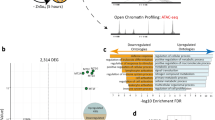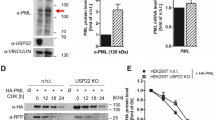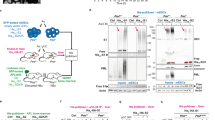Abstract
The promyelocytic leukemia gene was first identified through its fusion to the gene encoding the retinoic acid receptor alpha (RARα) in acute promyelocytic leukemia (APL) patients. The promyelocytic leukemia gene product (PML) becomes conjugated in vivo to the small ubiquitin-like protein SUMO-1, altering its behavior and capacity to recruit other proteins to PML nuclear bodies (PML-NBs). In the NB4 cell line, which was derived from an APL patient and expresses PML:RARα, we observed a retinoic acid-dependent change in the modification of specific proteins by SUMO-1. To dissect the interaction of PML with the SUMO-1 modification pathway, we used the budding yeast Saccharomyces cerevisiae as a model system through expression of PML and human SUMO-1 (hSUMO-1). We found that PML stimulated hSUMO-1 modification in yeast, in a manner that was dependent upon PML's RING-finger domain. PML:RARα also stimulated hSUMO-1 conjugation in yeast. Interestingly, however, PML and PML:RARα differentially complemented yeast Smt3p conjugation pathway mutants. These findings point toward a potential function of PML and PML:RARα as SUMO E3 enzymes or E3 regulators, and suggest that fusion of RARα to PML may affect this activity.
This is a preview of subscription content, access via your institution
Access options
Subscribe to this journal
Receive 50 print issues and online access
$259.00 per year
only $5.18 per issue
Buy this article
- Purchase on SpringerLink
- Instant access to full article PDF
Prices may be subject to local taxes which are calculated during checkout





Similar content being viewed by others
Abbreviations
- APL:
-
acute promyelocytic leukemia
- ATRA:
-
all-trans-retinoic acid
- PML:
-
promyelocytic leukemia gene product
- PML-NBs:
-
PML-nuclear bodies
- RARα:
-
retinoic acid receptor alpha
- SDS–PAGE:
-
SDS–polyacrylamide gel electrophoresis
- SUMO:
-
small ubiquitin-like modifier
References
Azuma Y, Arnaoutov A, Dasso M . (2003). J Cell Biol 163: 477–487.
Azuma Y, Tan SH, Cavenagh MM, Ainsztein AM, Saitoh H, Dasso M . (2001). FASEB J 15: 1825–1827.
Bernardi R, Pandolfi PP . (2003). Oncogene 22: 9048–9057.
Borden KL . (2002). Mol Cell Biol 22: 5259–5269.
Chen XL, Reindle A, Johnson ES . (2005). Mol Cell Biol 25: 4311–4320.
Dohmen RJ, Stappen R, McGrath JP, Forrova H, Kolarov J, Goffeau A et al. (1995). J Biol Chem 270: 18099–18109.
Duprez E, Saurin AJ, Desterro JM, Lallemand-Breitenbach V, Howe K, Boddy MN et al. (1999). J Cell Sci 112 (Part 3): 381–393.
Goddard AD, Borrow J, Solomon E . (1992). Leukemia 6 (Suppl 3): 117S–119S.
Hochstrasser M . (2000). Nat Cell Biol 2: E153–E157.
Hochstrasser M . (2001). Cell 107: 5–8.
Ishov AM, Sotnikov AG, Negorev D, Vladimirova OV, Neff N, Kamitani T et al. (1999). J Cell Biol 147: 221–234.
Jensen K, Shiels C, Freemont PS . (2001). Oncogene 20: 7223–7233.
Johnson ES . (2004). Annu Rev Biochem 73: 355–382.
Johnson ES, Gupta AA . (2001). Cell 106: 735–744.
Johnson ES, Schwienhorst I, Dohmen RJ, Blobel G . (1997). EMBO J 16: 5509–5519.
Kamitani T, Kito K, Nguyen HP, Wada H, Fukuda-Kamitani T, Yeh ET . (1998). J Biol Chem 273: 26675–26682.
Lallemand-Breitenbach V, Zhu J, Puvion F, Koken M, Honore N, Doubeikovsky A et al. (2001). J Exp Med 193: 1361–1371.
Lorick KL, Jensen JP, Fang S, Ong AM, Hatakeyama S, Weissman AM . (1999). Proc Natl Acad Sci USA 96: 11364–11369.
Melnick A, Licht JD . (1999). Blood 93: 3167–3215.
Muller S, Matunis MJ, Dejean A . (1998). EMBO J 17: 61–70.
Negorev D, Maul GG . (2001). Oncogene 20: 7234–7242.
Quimby BB, Wilson CA, Corbett AH . (2000). Mol Biol Cell 11: 2617–2629.
Saitoh H, Sparrow DB, Shiomi T, Pu RT, Nishimoto T, Mohun TJ et al. (1998). Curr Biol 8: 121–124.
Seufert W, Futcher B, Jentsch S . (1995). Nature 373: 78–81.
Strudwick S, Borden KL . (2002). Leukemia 16: 1906–1917.
Strunnikov AV, Aravind L, Koonin EV . (2001). Genetics 158: 95–107.
Takahashi Y, Iwase M, Konishi M, Tanaka M, Toh-e A, Kikuchi Y . (1999). Biochem Biophys Res Commun 259: 582–587.
Takahashi Y, Kahyo T, Toh EA, Yasuda H, Kikuchi Y . (2001). J Biol Chem 276: 48973–48977.
Weis K, Rambaud S, Lavau C, Jansen J, Carvalho T, Carmo-Fonseca M et al. (1994). Cell 76: 345–356.
Zhao X, Blobel G . (2005). Proc Natl Acad Sci USA 102: 4777–4782.
Zhong S, Muller S, Ronchetti S, Freemont PS, Dejean A, Pandolfi PP . (2000). Blood 95: 2748–2752.
Acknowledgements
This work is dedicated to Byrn Burch who died of leukemia on October 17, 2002. This work was supported by the Intramural Research Program of the NICHD/NIH. BB Quimby was supported by a Pharmacology Research Associate Training (PRAT) fellowship. Studies on PML were initiated with support from HFSP Research Grant RG0229/1999-M.
Author information
Authors and Affiliations
Corresponding author
Additional information
Supplementary Information accompanies the paper on Oncogene website (http://www.nature.com/onc)
Supplementary information
Rights and permissions
About this article
Cite this article
Quimby, B., Yong-Gonzalez, V., Anan, T. et al. The promyelocytic leukemia protein stimulates SUMO conjugation in yeast. Oncogene 25, 2999–3005 (2006). https://doi.org/10.1038/sj.onc.1209335
Received:
Revised:
Accepted:
Published:
Issue date:
DOI: https://doi.org/10.1038/sj.onc.1209335
Keywords
This article is cited by
-
SUMO E3 ligase activity of TRIM proteins
Oncogene (2011)
-
New insights into the role of PML in tumour suppression
Cell Research (2008)
-
SUMO junction—what's your function?
EMBO reports (2007)
-
SUMOylation of Tr2 orphan receptor involves Pml and fine-tunes Oct4 expression in stem cells
Nature Structural & Molecular Biology (2007)
-
Structure, dynamics and functions of promyelocytic leukaemia nuclear bodies
Nature Reviews Molecular Cell Biology (2007)



